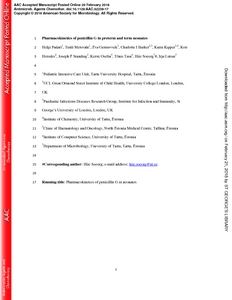Padari, H;
Metsvaht, T;
Germovsek, E;
Barker, CI;
Kipper, K;
Herodes, K;
Standing, JF;
Oselin, K;
Tasa, T;
Soeorg, H;
et al.
Padari, H; Metsvaht, T; Germovsek, E; Barker, CI; Kipper, K; Herodes, K; Standing, JF; Oselin, K; Tasa, T; Soeorg, H; Lutsar, I
(2018)
Pharmacokinetics of penicillin G in preterm and term neonates.
Antimicrob Agents Chemother, 62 (5).
e02238-17.
ISSN 1098-6596
https://doi.org/10.1128/AAC.02238-17
SGUL Authors: Barker, Charlotte Ida Sophia
![[img]](https://openaccess.sgul.ac.uk/109632/1.hassmallThumbnailVersion/AAC2018Padari.pdf)  Preview |
|
PDF
Accepted Version
Available under License ["licenses_description_publisher" not defined].
Download (1MB)
| Preview
|
Abstract
Group B streptococci are common causative agents of early-onset neonatal sepsis (EOS). Pharmacokinetic (PK) data for penicillin G have been described for extremely preterm neonates but poorly for late-preterm and term neonates. Thus, evidence-based dosing recommendations are lacking. We described PK of penicillin G in neonates with gestational age (GA) ≥32 weeks and postnatal age <72 h. Penicillin G was administered intravenously at a dose of 25,000 or 50,000 IU/kg/q12h. At steady state, PK blood samples were collected prior to and at 5 min, 1 h, 3 h, 8 h, 12 h after injection. Non-compartmental PK analysis was performed with WinNonlin. In combination with data from neonates with GA ≤28 weeks we developed a population PK model using NONMEM software and performed probability of target attainment (PTA) simulations. In total, 16 neonates with GA ≥32 weeks were included in non-compartmental analysis. The median (interquartile range) volume of distribution (VD) was 0.50 (0.42-0.57) L/kg, clearance (CL) 0.21 (0.16-0.29) L/h and half-life 3.6 (3.2-4.3) h. In population PK analysis that included 35 neonates, a two-compartment model best described the data. The final parameter estimates were 10.3 L/70kg and 29.8 L/70kg for VD of the central and peripheral compartment, respectively, and 13.2 L/h/70kg for CL. Considering fraction of unbound penicillin G of 40%, PTA of time when the unbound drug exceeds MIC of 40% was >90% for MICs ≤2 mg/L with doses of 25,000 IU/kg/q12h. In neonates, regardless of GA, PK parameters of penicillin G are similar. The dose of 25,000 IU/kg/q12h is suggested for treatment of group B streptococcal EOS diagnosed within the first 72 hours of life.
Statistics
Item downloaded times since 27 Feb 2018.
Actions (login required)
 |
Edit Item |



